Okonomiyaki History
Let's start with the name - it basically means "what you like, grilled".Yaki means grilled or cooked
Okonomi means "what you want" or "what you like"
So, of course, this means that there is no "one" way to make Okonomiyaki and no "one" recipe that defines it - it is very much up to the chef or customer what it ultimately looks like - just like no two American meatloaf or Italian tomato sauce recipes are quite the same.
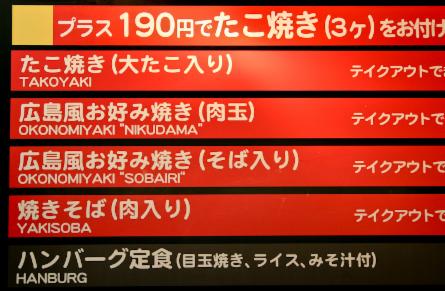
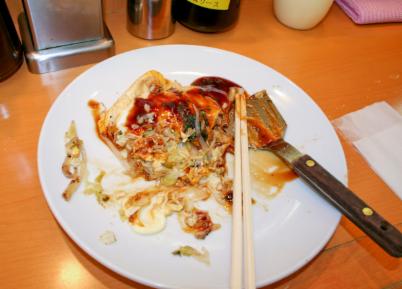
Menu and an almost finished meal at an Okonomiyaki Restaurant just outside the Akihabara Metro station exit in Tokyo.
History
Okonomiyaki was invented in Japan prior to World War II and evolved and became popular during and after the war. The earliest origins of a basic crepe-like pancake date back to the Edo period (1683-1868) period where these were a special desert served at Buddhist ceremonies called Funoyaki. This then evolved during the Meiji period (1868-1912) into a sweeter dish called Sukesoyaki. During the 20's and 30's the dish continued to evolve with more emphasis put on the sauces added and the name Yoshokuyaki began to be used. The name Okonomiyaki started in the late 30's in Osaka. In Hiroshima at this time a similar crepe-like food was popular - it was topped with onions, folded over, and served to children as a snack item. Okonomiyaki, in it's different variations, started to become more popular during the war when rice became scarce and residents had to be creative in using other more readily available ingredients. The simple wheat pancake fit the bill and during and after the war, people started to add more ingredients such as eggs, pork, and cabbage. A restaurant from Osaka claims to have been the first to add Mayonnaise in 1946.Main Variations
There are two significantly different types of Okonomiyaki. First, the Kansai or Osaka style, in which the ingredients are all mixed into a batter and then grilled. Second, the Hiroshima style, in which a small crepe-like pancake is grilled and then other ingredients are layered on top. The Hioshima style uses much more cabbage than the Osaka style.Kansei / Osaka Style
This is the type of Okonomiyaki that our "Best Okonomiyaki Recipe" is focused on. All the ingredients are mixed into a batter which is grilled on both sides and then has various topping added. At some restaurants this is just served up, with a couple variations to choose from, sometimes grilled in a huge sheet and an individual portion cut out, and you add your own condiments. At other restaurants you choose exactly the ingredients you want and the Okonomiyaki is cooked right in front of you, either by the chef or by yourself.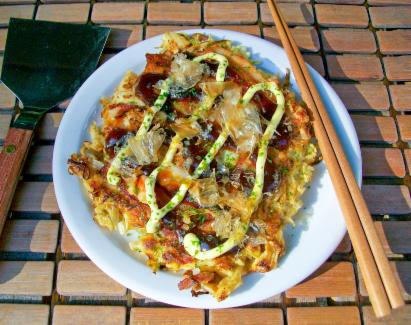
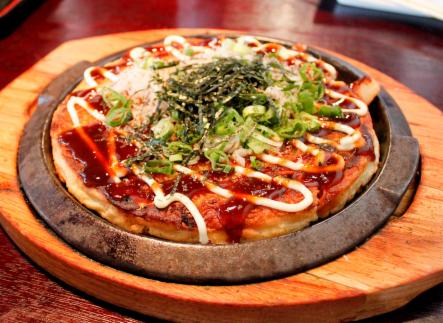
Hiroshima Style
In the Hiroshima Style Okonomiyaki, a small thin pancake is grilled and then other ingredients are layered on top, starting with a large amount of shredded cabbage. Other ingredients are added in layers, and then the pancake is flipped onto fried eggs on one or both sides before serving. Hiroshima style also often include fried noodles.Okonomiyaki Nikudama or Nikutama includes noodles and pork.
(Nikutama-soba with thin yakitori noodles or Nikutama-udon with thicker udon noodles)

These photos courtesy of and Copyright (C) 2007 Hiroshima Prefecture -Tourism Promotion Office of the Hiroshima Prefectural Government
Negiyaki
Negiyaki is very similar to Okonomiyaki, but instead of cabbage uses all green onions. It's similar to a Korean pancake, Pajeon.
Tokyo Style - Monjayaki
Monjayaki or Monja-Yaki is a variation of Okonomiyaki that is also called Tokyo-style. The main ingredients are grilled first, moved into a ring, and the batter is added to the middle. It ends up being much runnier than the other styles and is eaten directly off the grill using the Okonomiyaki spatula.Takoyaki
Takoyaki is not really an Okonomiyaki, but is similar and often served at the same restaurants. It is a batter with Tako (Octopus) that is cooked into a ball and served in a similar way, with the same condiments (sweet sauce, mayonnaise, bonito flakes, seeweed flakes).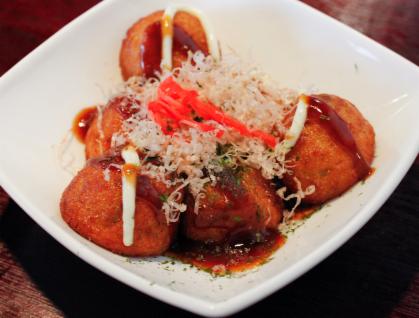
.